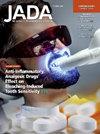牙周病与st段抬高型心肌梗死住院结局之间的关系:来自全国住院患者样本的见解
IF 3.1
2区 医学
Q1 DENTISTRY, ORAL SURGERY & MEDICINE
引用次数: 0
摘要
背景:牙周病(PD)与心血管发病率增加有关,但其对st段抬高型心肌梗死(STEMI)预后的影响仍未得到充分研究。作者研究了PD对STEMI预后的影响。方法:作者分析了2016-2019年全国住院患者样本数据集中的STEMI住院情况,比较了PD患者和非PD患者的结局。主要和次要结局包括死亡率、机械循环支持、机械通气、血管加压药使用、心源性休克、急性肾损伤、住院时间和住院总费用。多变量回归校正了混杂因素。结果:在2,595,584例STEMI住院患者中,0.2%涉及PD的国际疾病分类第十版临床修改代码。PD编码与较高的机械循环支持使用几率相关(调整OR [aOR], 1.57;95% CI, 1.25 ~ 1.97),机械通气(aOR, 1.26;95% CI, 1.01 ~ 1.58),心源性休克(aOR, 1.48;95% CI, 1.20 ~ 1.83),急性肾损伤(aOR, 1.32;95% CI, 1.13 - 1.55),更长的住院时间(7.18 vs 4.40天;P < 0.001)和更高的住院费用(141,245美元vs 98,152美元;P < 0.001)。死亡率和血管加压药的使用没有变化。结论:在STEMI病例中,伴发PD代码与非致命性不良事件和医疗资源使用的较高几率相关。实际意义:认识到PD是STEMI的合并症可能有助于制定护理策略,减少不良后果,并改善临床实践中的资源分配。进一步的研究可以完善风险分层方法。本文章由计算机程序翻译,如有差异,请以英文原文为准。
Associations between periodontal disease and hospitalization outcomes in ST-segment elevation myocardial infarction
Background
Periodontal disease (PD) is linked to increased cardiovascular morbidity, but its impact on outcomes in ST-segment elevation myocardial infarction (STEMI) remains understudied. The authors investigated the effect of PD on STEMI outcomes.
Methods
The authors analyzed STEMI hospitalizations from the 2016-2019 National Inpatient Sample data set, comparing outcomes in patients with and without PD. Primary and secondary outcomes included mortality, mechanical circulatory support, mechanical ventilation, vasopressor use, cardiogenic shock, acute kidney injury, hospital length of stay, and total hospital cost. Multivariable regression adjusted for confounding factors.
Results
Of 2,595,584 STEMI hospitalizations, 0.2% involved patients with an International Classification of Diseases, Tenth Revision, Clinical Modification code for PD. A PD code was associated with higher odds of mechanical circulatory support use (adjusted OR [aOR], 1.57; 95% CI, 1.25 to 1.97), mechanical ventilation (aOR, 1.26; 95% CI, 1.01 to 1.58), cardiogenic shock (aOR, 1.48; 95% CI, 1.20 to 1.83), acute kidney injury (aOR, 1.32; 95% CI, 1.13 to 1.55), longer hospital stays (7.18 vs 4.40 days; P < .001), and higher hospital costs ($141,245 vs $98,152; P < .001). Mortality and vasopressor use were unchanged.
Conclusions
Among STEMI cases, a concomitant PD code was associated with higher odds of nonfatal adverse events and health care resource use.
Practical Implications
Recognizing PD as a comorbidity in STEMI may help tailor care strategies, reduce adverse outcomes, and improve resource allocation in clinical practice. Further studies could refine risk-stratification approaches.
求助全文
通过发布文献求助,成功后即可免费获取论文全文。
去求助
来源期刊

Journal of the American Dental Association
医学-牙科与口腔外科
CiteScore
5.30
自引率
10.30%
发文量
221
审稿时长
34 days
期刊介绍:
There is not a single source or solution to help dentists in their quest for lifelong learning, improving dental practice, and dental well-being. JADA+, along with The Journal of the American Dental Association, is striving to do just that, bringing together practical content covering dentistry topics and procedures to help dentists—both general dentists and specialists—provide better patient care and improve oral health and well-being. This is a work in progress; as we add more content, covering more topics of interest, it will continue to expand, becoming an ever-more essential source of oral health knowledge.
 求助内容:
求助内容: 应助结果提醒方式:
应助结果提醒方式:


